 A corner of our sitting room , with the latest addition- A restored antique steamer-trunk.
A corner of our sitting room , with the latest addition- A restored antique steamer-trunk.When we first saw this trunk, we didn’t want to touch it with a 10-foot pole. You’ll see what I mean when you scroll down. But I’ve been fascinated by my mothers old bridal trunk (which still awaits restoration), that I wanted to give this one a try for a pure "skills-test" purpose, before I ventured to take on larger projects.
After all-there’s still the option of putting it back on the kerb-side- in case things didn’t go as expected. :-P
After our usual modus operandi for tracking roots- which I must say has become a standardized process for us now (no ISO: 9001 yet, I confess), the process was something like this:
1. Trace by
Baggage labels /Railroad labels,
2. Trace by
Lock Manufacturer,
3. Trace by
Trunk Manufacturer,
4. Merge all Traces, and you can pretty much narrow down a period with reasonbly good accuracy.
We will merge history and cleaning lessions as we go down the path of restoration.
Below: As-is condition. Pretty gruesome (and smell of old leather- not the good one, the bad one I mean).
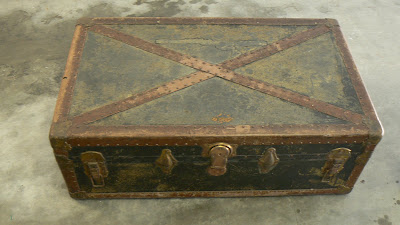
Cleaning 101. Use of harsh chemical will damage the leather (that the old owner definitely cared for! as we can see). Anyway, under "new ownership", we must try and do as best as we can, shouldnt we? So back to basics- lightly moistened papertowels, and good old fashioned rubbing the grime off...for a few hours.

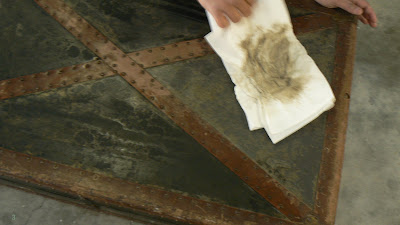
OK- onto History..
Trace by
Baggage labels /Railroad labels- This is an interesting part- where have thou been? I know some trunks have fabled journey’s proof including
travel labels from Shipping companies such as Cunard/White Star Lines (yep-The Titanic’s famed owner). Anyway, many of our trunk's labels are fully dilapidated, and in other places there are only marks that remain where labels have been. However, a few labels (newer ones) remain somewhat intact indicating last journeys around 1918-1928 - with the American Express Railroad Company (AREC) labels. AREC changed its name after 1929- so this trunk was on board, raibound, a few times before that year. (Labels show New York, Idaho, and Oakland, CA)
The details, I learnt, are very important in determining the age of trunks.
So now you know.
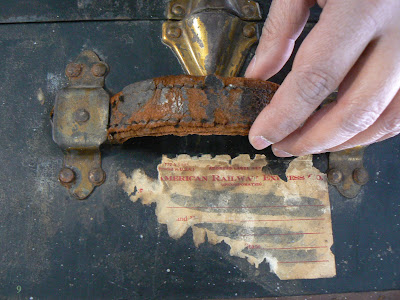
Above: One of the AREC labels, in still fairly readable form (i.e. The "printed" details. The handwritten details are long gone!)
 Above:
Above: Another label. Possibly the last stop, since it's in California! Ship COLLECT! Uh Oh. Which in shipping terms means that the Receiver bears ALL freight charges, and will pay upon receiving/collecting the item. (So I dont think very valuable freight like perfume, and linens and spices would have arrived, atleast on that last consignment :-) )
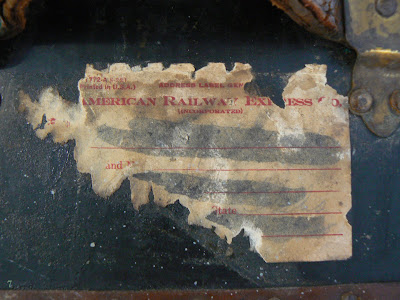
 Above:
Above: I really cant read this label, and I'm kinda cross-eyed by the time I got here. It does look intriguing though, and if anyone has any guesses, feel free to comment! (The letters AR are visible, and I think the next letter is G. Below are the smaller font words "Count on/off..whatever") Doesnt make much sense to me. Also is the small print "New York" on the below right corner.
OK, now... Trace by
Lock Manufacturer-
Before 1830's steamer trunks were mostly handmade, but after around 1836 the trunk locks started to be machine made. Eventually steamer trunk manufacturing boomed in the US during 1860-1900. By then, many makers of trunks outsourced the lock part to expert lock manufacturers like Yale, Excelsior and Hartmann to name a few.
Yale lock Company was established in 1868 in Stamford, CT, by Linus Yale Sr., and Henry Towne. Yale Sr (inventor of the
tumbler lock) died a few months after the company was formed, never knowing how
world famous his locks would eventually be. And partner Henry Towne was probably gentleman enough not to drop his deceased partner's name, and the company was renamed
Yale & Towne Manufacturing Co. in 1883. The reason I'm going to such depths is because ours bears the stamp of "
Yale & Towne Manufacturing Co.". So we now know that the trunk was manufactured after 1883- possibly very close to that period, and the last 'recorded' travels were around 1918-1929 (from the Railroad labels above as we saw).

Unfortunately our trunk came with no key. I discovered a site called
Antiquekeys, which will get you pretty much any key you may be looking for in your restoration. After photo-magnification (thanks to all the digital camera improvements in recent years), I could read through the rust, and see that our lock# was Yale-Y54.
**
Now back to "Cleaning", to give a break from our History lessons.
The fine art of rubbing with oil: This one was simply based on a whim. We initially tried cleaning it with the leather cleaner that I use for my car's inside. Not only was it a waste of cleaner- but it was more like a drop in the ocean on the century-plus old parched leather. A lightbulb moment brought us to try out with oil. (we used olive oil, but I'm sure you could do with others as well)- half a bowl should do the trick. At "First rub", the leather "drank" the oil, and we could see it dry up within a minute. Poor guy mustve been thirsty since the 1880's.
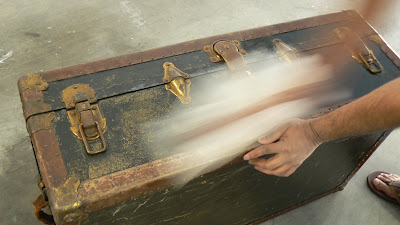
But the patience paid off. Subsequent rubs retained the oil, now that the leather was beginning to soak in it.
 Above:
Above: Aha...now we're getting somewhere. See the colour change, and the deep black beginning to show! I must say that I didnt have much hope on this after the initial rounds, that it would ever get back in this shape.
Below: The latch locks, tee up and fit perfectly, like it's just rolled off the assembly line. Pretty amazing build quality.

Trace by
Trunk Manufacturer- Trace the maker of the Trunk, or the retailer, or both, and find out the company history and period of existence.
The Manufacturer in our case:
Standswell Trunks. Fortunately, most part of the label remains. I could find almost no record on Standswell trunks as an independant manufaturer, though I did find links to Perkiomen Trunk & Bag Co. in Philadephia, PA. Later labels show the Standswell Diamond logo merged with the Perkiomen Logo. (It's reasonable to assume that Perkiomen might have aquired Standwell Trunks). You can find some pretty good history of Old Trunk labels on
OldTrunks.comAfter extensive searches, I still couldnt find even a single trunk with ONLY the "Standswell" emblem- like ours. (I found 1-2 with Standswell-Perkiomen merged emblem though). So in its own charming way, this piece we have could be a rare part of the Great American Trunk history after all! :-)
 Final Touches:
Final Touches: Cedar blocks on the inside to absorb any odor, and keep it clean for the years to come. We must say that were were absolutely thrilled at the end state, and also amazed at how sturdily they built trunks in the olden times. In spite of all the abuse it has gone through, the structure is rock-solid, and who knows-perhaps built to take a few more centuries on!
 Below:
Below: And so it has come to rest - for now. A conversation peice in our quiet chat corner. Thanks for stopping by, and look forward to your comments!







